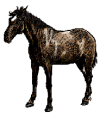

To send a message to an author, click on the author's name at the end of the article.
This Month in Ag Connection | Ag Connection - Other Issues Online

Ideally mares should be checked for pregnancy two weeks after ovulation and again at 30 and 90 days of pregnancy. The sooner you know which mares are not pregnant the sooner you can address the reasons why they are not. If you did not previously check for pregnancy, work with your veterinarian to do so now.
A number of factors can prevent a mare from becoming pregnant and maintaining the pregnancy. The easiest factors to address are management practices.
The greatest percentage of mares that do not settle is due to early embryonic loss.
Consult your veterinarian about any mare that has bred, not maintained the pregnancy and subsequently remained barren for two or more years.
Rhinopneumonitis (equine herpesvirus type 1) is the leading cause of late term abortion in mares. This virus is transmitted via respiratory secretions and/or airborne viral particles. Good management practices will aid in preventing this disease in your broodmare band.
Consult your veterinarian for information on diseases endemic to you area. Some of the common vaccines given to broodmares include eastern and western equine encephalomyelitis, tetanus, influenza, equine pneumonitis, and Potomac horse fever.
(Author: Preston R. Buff, Student, University of Missouri-Columbia)
This Month in Ag Connection] Ag Connection - Other Issues Online
For all but thirteen counties in Missouri, the fencing and boundary law changed on August 28, 2001. This will be the first change in the law for these counties in over 100 years.

The main updates include:
The new law further defines who is responsible for building and maintaining a boundary fence. Owning or running livestock appears to be the only reason you would be required to build and maintain a boundary fence. In the new law, your portion is that portion of the division fence which is on the right of each owner as they face the fence line while standing at the center of their common property line on their own property. Up until this law, the right ½ was tradition only and not law. It states further that existing agreements not consistent with the above (right ½ again) shall be in writing, signed by the agreeing parties (this would include spouses and any partners in the land) and be recorded in the recorder of deeds office in the county or counties where the fence line is located. This agreement (no matter which way it is) shall bind the makers (those doing the initial agreement or fence), their heirs and assigne (purchasers or otherwise owners of the land further down the road).
Another issue that was previously a problem was the situation where one landowner built a fence on the property line and the other put livestock on his land later on. Now, if one landowner builds and pays for a boundary fence, he/she may report the cost to the circuit court judge who then may authorize the recording of that amount on both deeds. If the other property owner later puts livestock on the property, the landowner who paid the original cost will be reimbursed for ½ of his/her cost.
What are the potential problems with this new law? While this law has certainly fixed some of the problems we've been dealing with for many years, it leads to several other questions. First, will judges interpret the law differently in different counties? The law says that if 2 landowners have a need for a fence, both must build one in a reasonable amount of time. What is reasonable and will it be the same in every county? Second, why does the law have the circuit judge record the cost onto both deeds? How long will it take after it is taken to their office to be recorded and what if it doesn't get done? Who will be liable in that situation later on? Third, will the landowner who later puts livestock on his land have to pay for ½ of the building cost no matter how many years later it happens? Does a judge have any right to adjust this (it would appear not)? Other issues will likely come up.
If you own land in Bates, Clinton, Daviess, Harrison, Knox, Linn, Mercer, Newton, Schuyler, Scotland, Shelby, Sullivan or St. Clair counties, the law there is very different.
View web sites listed below for further information:
(Author: Joseph W. Koenen, Farm Management Specialist, University Outreach and Extension )
This Month in Ag Connection | Ag Connection - Other Issues Online

An installment sale is the disposal of property where the seller receives at least one payment after the tax year of sale. The installment method cannot be used to report a loss. Utilizing installment sales allows cash-basis taxpayers to report portions of gain to multiple tax years as the installment payments are received. For the installment sale provision related parties are defined as: spouses, children, grandchildren, brothers, sisters, and parents. Additionally, a partnership or corporation in which the taxpayer has a controlling interest, or an estate or trust with which the taxpayer has a connection, can also be considered a related party. Two special rules apply to an installment sale between related parties.
A depreciation recapture rule, with or without a related party, requires the recapture of depreciation for Section 1245 (personal property) and Section 1250 (real property) assets as ordinary income in the year of sale. Thus, the installment method of reporting sales of depreciable property will normally be advantageous only if the sale price is substantially greater than the original cost.
Important Note: Raised breeding livestock sold to a related party would be captured under Rule #2 - since the breeding livestock would be depreciable by the purchaser.
(Author: Parman R. Green, University Outreach and Extension Farm Business Management Specialist)
This Month in Ag Connection | Ag Connection - Other Issues Online

If you will be buying forages or supplements this winter, try using the Comparative Value Spread Sheets available on the Ag Electronic Bulletin Board. Click here to view the beef spread sheet. Click here> to view the dairy address. These reports are updated weekly and can be used to compare the costs of purchased forages, by-product feeds and traditional corn/soy bases supplements.
You can click here to download both spreadsheets to your computer and then you can input your own corn and soybean meal prices for an individualized comparison.
| Item | Energy | Protein | Calcium | Phosphorus |
|---|---|---|---|---|
| Feed | Corn, Crkd | 48% SBM | Limestone | Dical |
| Cost $ | 2.22 $/Bu | 193.5 $/Ton | 4.74 $/cwt | 17.82 $/cwt |
| Calc $/cwt | $3.96 $/cwt | 9.68 $/cwt | ||
| D.M., % | 85.00 | 89.00 | 98.00 | 98.00 |
| C.P., % | 10.00 | 53.90 | ||
| NE Mcal/lb | 0.84 | 0.88 | ||
| Ca, % | 0.03 | 0.30 | 36.00 | 23.00 |
| Phos., % | 0.29 | 0.68 | 18.00 |
| Feed | D.M. % | C.P. % | ADF % | Ca % | Phos % | Value $/cwt DM |
Value $/ Ton As Fed** |
|---|---|---|---|---|---|---|---|
| Composition | % of Dry Matter | ||||||
| Alfalfa Mid Bloom | 91.0 | 30.0 | 33.0 | 1.50 | 0.33 | $7.04 | $128.11 |
| Brewers Grains, Dried | 92.0 | 25.4 | 0.41 | 0.33 | 0.55 | $5.59 | $102.89 |
| Corn Gluten Feed, Dried | 90.0 | 23.0 | 0.59 | 0.36 | 0.82 | $6.18 | $111.32 |
| Soy Hulls | 91.0 | 12.1 | 0.59 | 0.49 | 0.21 | $4.19 | $76.17 |
| Soybeans, Whole | 92.0 | 42.8 | 0.71 | 0.27 | 0.65 | $9.23 | $169.76 |
(Author: Mark Stewart, University Outreach & Extension Livestock Specialist)
This Month in Ag Connection | Ag Connection - Other Issues Online

Gain valuable feedlot performance and carcass information by participating in retained ownership without the investment and risk of feeding an entire pen of cattle. A minimum of 5 steers born after January 1, 2001 can be entered. Deadline for entry is October 15, 2001. Steers are required to be weaned and meet the immunization program. For more information and entry forms contact your local Outreach & Extension office.
(Author: Wesley Tucker, University Outreach and Extension Farm Management Specialist)
This Month in Ag Connection | Ag Connection - Other Issues Online
Publishing Information
Ag Connection is published monthly for Northeast and Central areas of Missouri producers and is supported by the University of Missouri Extension, the Missouri Agricultural Experiment Station, and the MU College of Agriculture, Food and Natural Resources. Managing Editor: Mary Sobba.